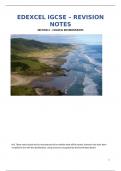EDEXCEL IGCSE – REVISION
NOTES
SECTION 2 – COASTAL ENVIRONMENTS
N.B. These notes should not be misconstrued to be entirely what will be tested, however they have been
compiled in line with the Specification, using resources recognised by the Examination Board.
1
,Table of Contents – Coastal Environments
2.1 Physical processes and human intervention give rise to characteristic coastal landforms…………………3
a) Physical processes at work on the coast: marine processes (wave action, erosion, deposition, and
transportation, including longshore drift), weathering (mechanical, chemical and biological) and mass
movement (sliding and slumping)………………………………………………………………………………………………………3
b) Influence of geology, vegetation, people and sea-level changes on coastal environments……………10
c) Role of erosional and depositional processes in the development of landforms: headlands and bays,
cliffs, wave-cut platforms, caves, arches, stacks and stumps, beaches, spits and bars……………………….11
2.2 Distinctive ecosystems develop along particular stretches of coastline…………………………………………..14
a) Distributions and features of the world’s coastal ecosystems (coral reefs, mangroves, sand dunes
and salt marches)……………………………………………………………………………………………..……………………………..14
b) Abiotic and biotic characteristics of one named coastal ecosystem………..…………………………………….17
c) How small- and large-scale coastal ecosystems are threatened by people and their activities
(industrialisation, agricultural practices, tourism and deforestation)………….…………………………………….17
2.3 Coastal environments are of great importance to people and need to be sustainably managed……..18
a) Conflicts between different users of the coast, with different views on coastal management
(conservation or development)…………..……………………………………………………………………………………………18
b) Causes of coastal flooding (storm surges, tsunamis, climate change) and the prediction and
prevention of flooding (forecasting, building design, planning and education)………….……………………..19
c) There are different coastal management strategies, including soft engineering (beach replenishment,
cliff regrading, ecosystem rehabilitation and revegetation, managed retreat), hard engineering
(groynes, revetments, sea walls, gabions, riprap) and shoreline management plans.)………………………20
Specification
2
, 2.1(
a) Physical processes at work on the coast
---
Marine processes -
Wave action:
Constructive Waves
Low energy waves
Strong swash and weak backwash
~ Strong swash brings sediments in to build the beach
~ Weak backwash cannot remove the sediments
Low frequency, 6-8 per minute
Low wave height, but long wavelength
--
Destructive Waves
Lots of energy
Strong backwash and weak swash
~ Tall breakers break downwards with great force
~ Strong backwash pulls the sand backwards
High frequency, 10-12 per minutes
High wave height, but low wavelength
3
,Erosion:
Hydraulic Action
This is the force of the water hitting the coastline, assisted by the cycle of compression and
decompression of air in openings in the rock as the wave strike and then recedes (cavitation)
--
Abrasion (Corrasion)
The sediment carried by the breaking waves in throwing against the coastline.
--
Corrosion (Solution)
Certain rock types can be dissolved by sea water (e,g, chalk and limestone.)
4
,--
Attrition
This does not erode the coastline itself but causes particles of sediment that are carried in the sea
to become smaller and rounder over time as they collide with and rub against each other.
Transportation of Sediment
Traction
Pebbles and large sediments are rolled along the sea bed.
--
Saltation
Load is bounced along the sea bed, e.g. small pieces of shingle or large sand grains.
Currents cannot keep the larger and heavier sediment afloat for long periods of time.
5
, Suspension
Small particles are carried in water, e.g. salts and clay which make the water look cloudy.
Currents pick up large amounts of sediment in suspension during storms, when strong winds
generate huge energy waves.
--
Solution
Minerals are dissolved in sea water and carried in solution.
The load is not visible.
Load can come from cliffs made from chalk or limestone, and calcium carbonate carried in solution.
Longshore Drift (LSD)
This is the transport of minerals along the coastline in the same direction as prevailing winds and wave
conditions.
1.The wind blows the waves onto the beach at an angle.
2. After the wave breaks, the swash moves the material up the beach at any angle.
3. Gravity pulls the backwash straight back down the beach at right angles to the coastline.
6




